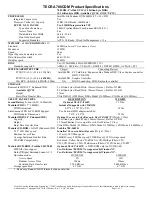
4-4 Using the Hardware
Windows 95 keys
— If you have Windows 95, you can use the following
two key combinations to facilitate your work.
Fn
+
x
– Quick access to shortcut menus
Fn
+
z
– Display the Start menu
Cursor Control keys — These keys position the cursor on the screen
where you want. The cursor is a blinking underline or block, depending
on the application. The cursor indicates where to insert the next text.
Typewriter keys — The typewriter keys (also called alphanumeric keys)
are used to enter text and characters. Keys with blue printing on them
behave differently when combined with control keys or the Fn key.
Numeric Keypad — Pressing
Num Lock
on the keyboard activates the
numeric keypad numbers and functions printed in blue on the keys. Num
Lock works only when no external keyboard or scanner is connected.
The keypad lets you type numbers and mathematical operands (+, –) like
on a calculator. The keypad is ideal for entering long lists of numbers.
When you press Num Lock again, the keys revert to their normal func-
tions as typewriter keys.
Control keys —
Ctrl
,
Fn
,
Alt
, and
Shift
are controls used in conjunction
with other keys to change their functions. To use control keys, press and
hold the control key while pressing another key. For example, “press
Ctrl
c
” means to hold down the
Ctrl
key and type the letter
c
. How the key
combination works depends on the applications you are running.
NEC VERSAGLIDE
The NEC VersaGlide is an easy way to control the cursor with your finger.
Lightly glide your finger across the NEC VersaGlide and the cursor follows.
Tapping gently, you can select items in one of two ways:
Double tap your finger on the VersaGlide.
Double click the left button (this is the primary button). You can select
the right button as your primary button. See the section, Changing the
Button Configuration.
Summary of Contents for VERSA 4200
Page 11: ...viii Contents ...
















































